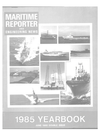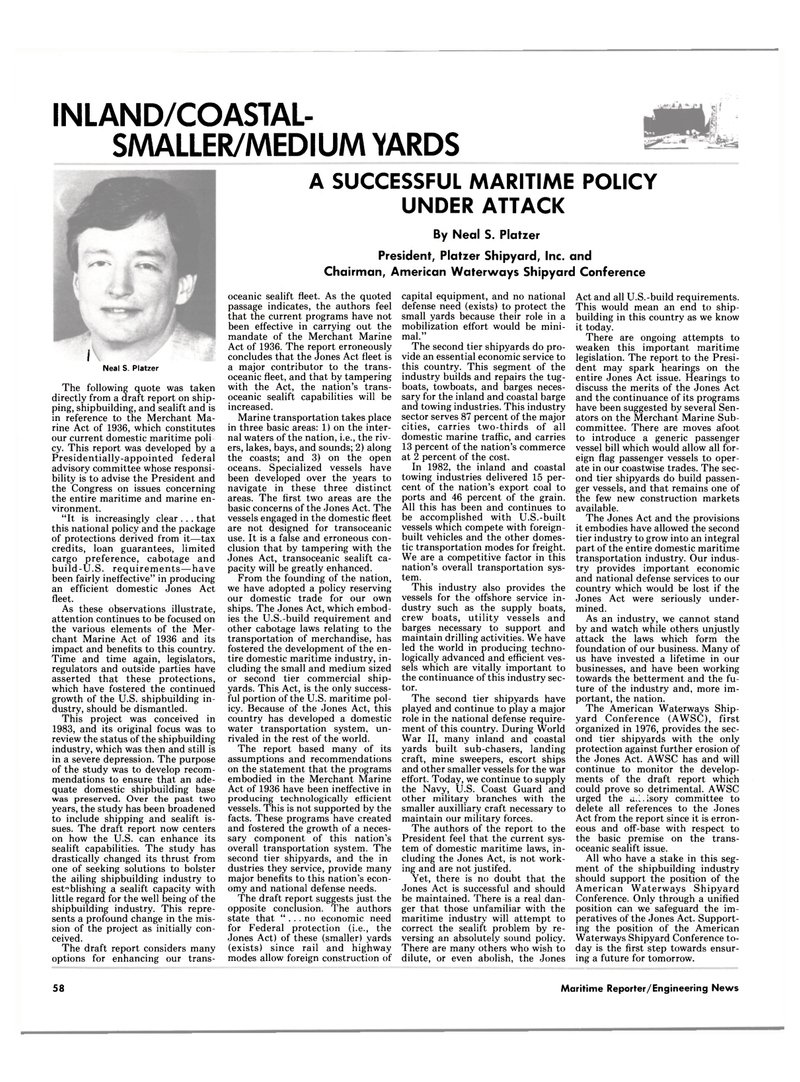
Page 60: of Maritime Reporter Magazine (June 1985)
Read this page in Pdf, Flash or Html5 edition of June 1985 Maritime Reporter Magazine
INLAND/COASTAL-
SMALLER/MEDIUM YARDS
The following quote was taken directly from a draft report on ship- ping, shipbuilding, and sealift and is in reference to the Merchant Ma- rine Act of 1936, which constitutes our current domestic maritime poli cy. This report was developed by a
Presidentially-appointed federal advisory committee whose responsi- bility is to advise the President and the Congress on issues concerning the entire maritime and marine en- vironment. "It is increasingly clear . . . that this national policy and the package of protections derived from it—tax credits, loan guarantees, limited cargo preference, cabotage and build-U.S. requirements—have been fairly ineffective" in producing an efficient domestic Jones Act fleet.
As these observations illustrate, attention continues to be focused on the various elements of the Mer- chant Marine Act of 1936 and its impact and benefits to this country.
Time and time again, legislators, regulators and outside parties have asserted that these protections, which have fostered the continued growth of the U.S. shipbuilding in- dustry, should be dismantled.
This project was conceived in 1983, and its original focus was to review the status of the shipbuilding industry, which was then and still is in a severe depression. The purpose of the study was to develop recom- mendations to ensure that an ade- quate domestic shipbuilding base was preserved. Over the past two years, the study has been broadened to include shipping and sealift is- sues. The draft report now centers on how the U.S. can enhance its sealift capabilities. The study has drastically changed its thrust from one of seeking solutions to bolster the ailing shipbuilding industry to establishing a sealift capacity with little regard for the well being of the shipbuilding industry. This repre- sents a profound change in the mis- sion of the project as initially con- ceived.
The draft report considers many options for enhancing our trans-
A SUCCESSFUL MARITIME POLICY
UNDER ATTACK
By Neal S. Platzer
President, Platzer Shipyard, Inc. and
Chairman, American Waterways Shipyard Conference oceanic sealift fleet. As the quoted passage indicates, the authors feel that the current programs have not been effective in carrying out the mandate of the Merchant Marine
Act of 1936. The report erroneously concludes that the Jones Act fleet is a major contributor to the trans- oceanic fleet, and that by tampering with the Act, the nation's trans- oceanic sealift capabilities will be increased.
Marine transportation takes place in three basic areas: 1) on the inter- nal waters of the nation, i.e., the riv- ers, lakes, bays, and sounds; 2) along the coasts; and 3) on the open oceans. Specialized vessels have been developed over the years to navigate in these three distinct areas. The first two areas are the basic concerns of the Jones Act. The vessels engaged in the domestic fleet are not designed for transoceanic use. It is a false and erroneous con- clusion that by tampering with the
Jones Act, transoceanic sealift ca- pacity will be greatly enhanced.
From the founding of the nation, we have adopted a policy reserving our domestic trade for our own ships. The Jones Act, which embod- ies the U.S.-build requirement and other cabotage laws relating to the transportation of merchandise, has fostered the development of the en- tire domestic maritime industry, in- cluding the small and medium sized or second tier commercial ship- yards. This Act, is the only success- ful portion of the U.S. maritime pol- icy. Because of the Jones Act, this country has developed a domestic water transportation system, un- rivaled in the rest of the world.
The report based many of its assumptions and recommendations on the statement that the programs embodied in the Merchant Marine
Act of 1936 have been ineffective in producing technologically efficient vessels. This is not supported by the facts. These programs have created and fostered the growth of a neces- sary component of this nation's overall transportation system. The second tier shipyards, and the in dustries they service, provide many major benefits to this nation's econ- omy and national defense needs.
The draft report suggests just the opposite conclusion. The authors state that "... no economic need for Federal protection (i.e., the
Jones Act) of these (smaller) yards (exists) since rail and highway modes allow foreign construction of capital equipment, and no national defense need (exists) to protect the small yards because their role in a mobilization effort would be mini- mal."
The second tier shipyards do pro- vide an essent ial economic service to this country. This segment of the industry builds and repairs the tug- boats, towboats, and barges neces- sary for the inland and coastal barge and towing industries. This industry sector serves 87 percent of the major cities, carries two-thirds of all domestic marine traffic, and carries 13 percent of the nation's commerce at 2 percent of the cost.
In 1982, the inland and coastal towing industries delivered 15 per- cent of the nation's export coal to ports and 46 percent of the grain.
All this has been and continues to be accomplished with U.S.-built vessels which compete with foreign- built vehicles and the other domes- tic transportation modes for freight.
We are a competitive factor in this nation's overall transportation sys- tem.
This industry also provides the vessels for the offshore service in- dustry such as the supply boats, crew boats, utility vessels and barges necessary to support and maintain drilling activities. We have led the world in producing techno- logically advanced and efficient ves- sels which are vitally important to the continuance of this industry sec- tor.
The second tier shipyards have played and continue to play a major role in the national defense require- ment of this country. During World
War II, many inland and coastal yards built sub-chasers, landing craft, mine sweepers, escort ships and other smaller vessels for the war effort. Today, we continue to supply the Navy, U.S. Coast Guard and other military branches with the smaller auxilliary craft necessary to maintain our military forces.
The authors of the report to the
President feel that the current sys- tem of domestic maritime laws, in- cluding the Jones Act, is not work- ing and are not justifed.
Yet, there is no doubt that the
Jones Act is successful and should be maintained. There is a real dan- ger that those unfamiliar with the maritime industry will attempt to correct the sealift problem by re- versing an absolutely sound policy.
There are many others who wish to dilute, or even abolish, the Jones
Act and all U.S.-build requirements.
This would mean an end to ship- building in this country as we know it today.
There are ongoing attempts to weaken this important maritime legislation. The report to the Presi- dent may spark hearings on the entire Jones Act issue. Hearings to discuss the merits of the Jones Act and the continuance of its programs have been suggested by several Sen- ators on the Merchant Marine Sub- committee. There are moves afoot to introduce a generic passenger vessel bill which would allow all for- eign flag passenger vessels to oper- ate in our coastwise trades. The sec- ond tier shipyards do build passen- ger vessels, and that remains one of the few new construction markets available.
The Jones Act and the provisions it embodies have allowed the second tier industry to grow into an integral part of the entire domestic maritime transportation industry. Our indus- try provides important economic and national defense services to our country which would be lost if the
Jones Act were seriously under- mined.
As an industry, we cannot stand by and watch while others unjustly attack the laws which form the foundation of our business. Many of us have invested a lifetime in our businesses, and have been working towards the betterment and the fu- ture of the industry and, more im- portant, the nation.
The American Waterways Ship- yard Conference (AWSC), first organized in 1976, provides the sec- ond tier shipyards with the only protection against further erosion of the Jones Act. AWSC has and will continue to monitor the develop- ments of the draft report which could prove so detrimental. AWSC urged the u.l.isory committee to delete all references to the Jones
Act from the report since it is erron- eous and off-base with respect to the basic premise on the trans- oceanic sealift issue.
All who have a stake in this seg- ment of the shipbuilding industry should support the position of the
American Waterways Shipyard
Conference. Only through a unified position can we safeguard the im- peratives of the Jones Act. Support- ing the position of the American
Waterways Shipyard Conference to- day is the first step towards ensur- ing a future for tomorrow. 58 Maritime Reporter/Engineering News 1
Neal S. Platzer

 59
59

 61
61
